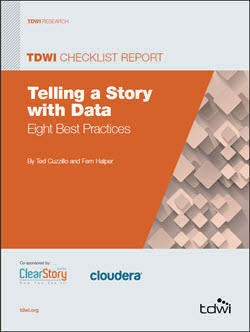
TDWI Checklist Report | Telling a Story with Data
November 7, 2014
Storytelling is every business person’s job. We all routinely present
data analysis, and each of us imagines the ultimate success: the
audience pays full attention and absorbs our full message. Even
better, people tell others about it, and each person heeds the call
to action.
All too often, however, we’re disappointed. Those in the audience
who should grasp the meaning in the numbers fail to do so.
Important messages are partially understood, misunderstood, or
ignored altogether.
A story—a narrative describing the pursuit of a goal that ends in
success or failure—captures our imagination. It can teach or inspire
us. It starts with a hook that grabs our attention, has a plot that holds
our interest, and ends with a resolution. A data story—a narrative
that includes analysis—can move beyond a simple recounting of
facts to weave together pieces of analysis that make an impact. These
stories can be written by individuals or groups to illustrate a variety of
business goals.
Understanding the potential for better results explains why data
storytelling is increasingly popular among business people. Traditional
storytelling in different media offers a rich tradition to learn from. This
checklist provides practical guidelines to nascent data storytellers.
It describes some important principles of data and analysis—the
supporting characters in a story—as well as some tips for making a
story engaging.